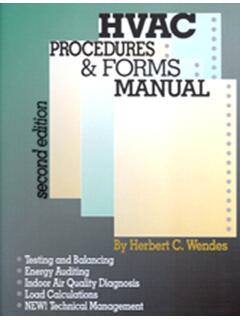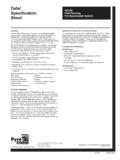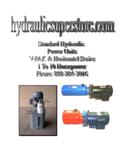Transcription of Air Conditioning Operation and Troubleshooting Handout
1 HVAC Service z Building Automation Systems z Boiler Services z Plumbing z Design/Build z Wastewater Services 3302 W. St. Joseph z Lansing, MI 48917 z z Ph z Fax Page 1 of 8 Air Conditioning Operation and Troubleshooting Matt Dunham Major Components (10 Minutes) Compressor heart of the system, causes refrigerant to flow by increasing the pressure of the refrigerant Metering Device fixed orifices and modulating (Expansion Style) o Thermostatic Expansion Device o Electronic Expansion Device Evaporator Absorbs heat into the refrigeration cycle. Condenser Rejects heat from the refrigeration cycle. Additional Components Indoors Evaporator and metering device Outdoors Compressor and Condenser Two connection lines o Suction Line - Larger line, typically insulated, vapor state, low pressure side o Liquid Line Smaller line, un-insulated, liquid state, high pressure Refrigerants (10 Minutes) R-22 (HCFC) o Contains chlorine, which is destructive to the ozone layer o Phased out of new equipment Jan 1, 2010 o Scheduled for no production January 1, 2020 o Typical operating pressures, HVAC Service z Building Automation Systems z Boiler Services z Plumbing z Design/Build z Wastewater Services 3302 W.
2 St. Joseph z Lansing, MI 48917 z z Ph z Fax Page 2 of 8 Low Pressures 55-80 PSIG, High Pressure 200-275 PSIG o Low Side Test Pressure 150 PSIG o High Side Test Pressure 300 PSIG o Mineral Oils or alkybenzines R-410A (HFC) o Zero Global Warming Potential o Runs much higher pressures o Typical operating pressures, Low Pressures 100-150 PSIG, High Pressure 315-450 PSIG o All equipment must be rated for 800 PSIG. o Low Side Test Pressure 450 PSIG o High Side Test Pressure 800 PSIG o POE Oils (Polyol Ester Oils) Conversion Equipment is not interchangeable. R-410A has the much higher test pressure Oils are not interchangeable, when mixed mineral oils and POEs turn into a chalky white power. Only the copper tubing can be reused, and should be flushed to remove mineral oil. Note: Manufactures are selling condensing units that are rated for R-22 and R-410A.
3 They come charged with dry nitrogen. Sequence of Operation (10 Minutes) 1. Thermostat calls for cooling, closes from R-Y and R-G. 2. Fan relay is energized fan cycles on High speed. 3. Call for cooling passes through all safeties; low pressure switch, high pressure switch, compressor lockout, and time delay. HVAC Service z Building Automation Systems z Boiler Services z Plumbing z Design/Build z Wastewater Services 3302 W. St. Joseph z Lansing, MI 48917 z z Ph z Fax Page 3 of 8 4. Cooling contactor energized powering the compressor and condenser fan. Electrical Components Indoor Fan Motor Compressor Condenser Fan Motor Capacitor Contactors Low Pressure Switch High Pressure Switch Time Delay Troubleshooting (35 Minutes) Two major categories o Electrical Problems o Refrigerant Problems Electrical Troubleshooting o Identify power sources.
4 SSU, circuit breaker Transformer provides 24V power o Identify consumers of power Motors Coils Transformers Valves o Identify paths of electrical flow Wiring Fuses o Identify controlling devices Switches Contacts Triacs (Circuit Boards) HVAC Service z Building Automation Systems z Boiler Services z Plumbing z Design/Build z Wastewater Services 3302 W. St. Joseph z Lansing, MI 48917 z z Ph z Fax Page 4 of 8 Checking Power Sources Meter set to voltage reading, one lead on L1 (Power, Hot), other lead on L2 (Common, Neutral) Reading should be the rated voltage +/- 10 percent o 24 V should be 24 +/- volts or to Checking Power Consumers (Loads) Use meter to ensure voltage is reaching device.
5 O One lead on the power source L2, with the other lead check for the L1 voltage at the device. Use meter to check continuity. o NOTE: Turn off power to unit. o Disconnect wiring from load to check o Set meter to continuity (ohms) place one lead on each side of the device where power is attached. Reading should be between 0 and OL (open line) for most devices. Manufacture may provide the precise reading. Use meter to check amp readings o Unit is running for these checks. o Meter is set to amps and clamped around one leg of power going to the load. Reading should be within 10 percent of the rated amp reading for the device. Checking Paths of Electrical Flow Use meter set to voltage, with one lead on the power source L2 utilize the hop-scotch method to identify were voltage is no longer present. The problem is just before this point. HVAC Service z Building Automation Systems z Boiler Services z Plumbing z Design/Build z Wastewater Services 3302 W.
6 St. Joseph z Lansing, MI 48917 z z Ph z Fax Page 5 of 8 Checking Controlling Devices Set meter to voltage and utilize the hop-scotch method to identify if there is a switching device that is not closing properly. With power removed continuity may also be check through a switch to identify if it is closing properly. Refrigerant Troubleshooting (20 Minutes) Properly operating system o The indoor coil should be cooler than the air passing over it. o The suction line will most likely be cool to the touch. o Air coming off the condenser will feel warm. o Liquid line will typically not feel hot or cold to the touch. o Discharge air to the conditioned space will be around 55 F. Common Causes for Refrigerant Problems o Low Air Flow Dirty Filter Vegetation Cottonwood Bad indoor fan motor Bad condenser fan motor o Low Refrigerant Charge Visible signs of oil on piping or coils.
7 Bubbles in a sight glass Evaporator coil developing ice Compressor running, suction line is not cool to the touch HVAC Service z Building Automation Systems z Boiler Services z Plumbing z Design/Build z Wastewater Services 3302 W. St. Joseph z Lansing, MI 48917 z z Ph z Fax Page 6 of 8 Troubleshooting Compressors Motor Terminals, Common (C), Start (S), Run (R) Checking compressor windings Run to Common Lowest Resistance Run to Start Highest Resistance Common to Start Intermediate resistance Note: R-S = C-S + C-R and C-S is normally 3-4 times greater than C-R Common Compressor Failures Electrical Failures Burnout Winding inside the compressor shell overheat and burn up.
8 Insulating coating on windings is burned. Once removed piping should be flushed with a refrigeration system flush to avoid contaminating new compressor. Compressor shorted to ground. Ohm reading between the compressor terminals and ground is around 0 ohms. Thermal overload will not reset. If thermal overload is tripped, remove power and allow time for the compressor to cool off, usually 1 hour. Mechanical Failure Locked Rotor The compressor has seized up internally and the amp draw when the compressor tries to HVAC Service z Building Automation Systems z Boiler Services z Plumbing z Design/Build z Wastewater Services 3302 W. St. Joseph z Lansing, MI 48917 z z Ph z Fax Page 7 of 8 start will be equal to or greater than the locked rotor amps (LRA) of the compressor.
9 Bad valves Typically with valves that have went bad in a compressor the amp draw of the compressor will be significantly lower than the full loaded amps (FLA) of the compressor. There will also be a lower pressure increase across the compressor from low to high pressure. Compressor Replacement (25 Minutes) 1. Lock out power to the unit and disconnect electrical from the compressor. 2. Determine if compressor was a burnout or not. If compressor burned out refrigerant will be recovered and then must be disposed of properly. 3. Recover refrigerant from the system into a DOT approved cylinder. 4. Use the appropriate tools to disconnect the existing compressor from the refrigerant lines. 5. Unbolt and remove the compressor physically from the condensing unit. 6. Mount the new compressor in the unit. 7. Install a liquid line filter dryer. Caution protect the filter dryer from overheating with wet rags while brazing in place.
10 8. Purge the system with dry nitrogen while reconnecting the refrigerant lines. 9. Pressure test the system with nitrogen to ensure no additional leaks, do not exceed the low side test pressure. Typically150 PSIG for R-22, 450 PSIG for R-410a. HVAC Service z Building Automation Systems z Boiler Services z Plumbing z Design/Build z Wastewater Services 3302 W. St. Joseph z Lansing, MI 48917 z z Ph z Fax Page 8 of 8 10. Use a vacuum pump and thermister gauge to draw the system into a deep vacuum. This should be below 500 microns. 11. Fill the system with the appropriate refrigerant to the proper level. This should be the factory charge, plus any additional charge required for additional line set lengths.





